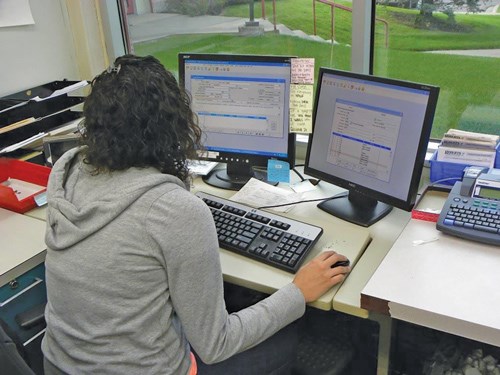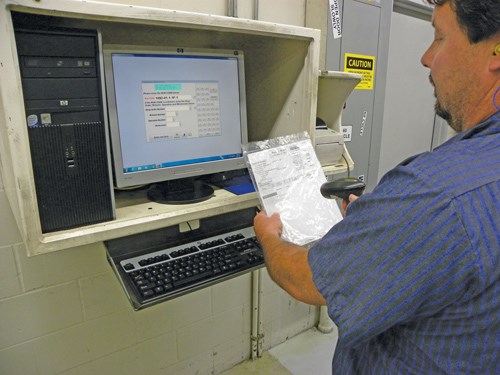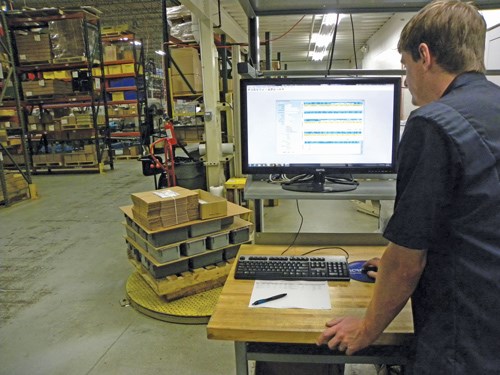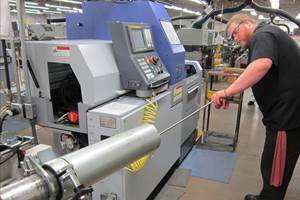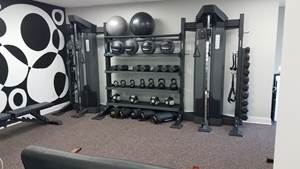Family Business Finds ERP Software Tailored to its Needs
When Jim Roberts and the rest of the management team at Roberts Automatic Products decided that they had to purchase an ERP software system for their growing company, it was anything but an easy decision.
Like many family-owned businesses, Roberts Automatic had grown through the years by doing whatever it took to survive and thrive. Writing their own ERP software program was one of the tasks the company undertook, which required always having a programmer on staff to update, tweak and reprogram the software. But when the UNIX system they built was about to break down and its programmer was retiring, it became clear that it was time to migrate to software available on the market that was targeted to their industry.
“The day we all agreed that we were going to begin the process of investigating new software was a scary day,” says President Jim Roberts. “We knew that no matter what system we settled on, there was going to be a lot of time invested for all of us to convert and get comfortable with this new system. Furthermore, because we had built the current system ourselves, we knew that any off-the-shelf system might not be as good as what we currently had, in some instances.”
The company was founded in 1947 by Jim’s grandfather. Jim’s dad, Walt, then took over the company and ran it successfully for 40 years as a traditional job shop before Jim and his brother Ted took over the operation in the early 1990s. Today, the third generation company continues to grow and expand. Roberts Automatic positions itself as more of a contract manufacturer than simply a job shop.
Dealing with Variety
“We have a variety of customers,” Mr. Roberts explains. “Each customer is different with their own particular needs in terms of tight tolerances, level of cleanliness required, finishes, quality level, how they require their parts labeled, shipped, and so on. Although our company can satisfy the most demanding customer through the improvements we have made in the business over the years, including the addition of robotics, we can also handle the everyday parts that are not as demanding and still be very competitive on producing those parts.”
Roberts Automatic’s staff of 50 works three shifts out of its 50,000-square-foot building. Roberts runs 25 screw machines including Acme-Gridleys, Davenports and Gildemeisters. It also has three CNC vertical machining centers and multiple two- and three-spindle milling machines.
Mr. Roberts determined more than 15 years ago that it would be advantageous to get ISO certification for the company, and he did just that. He can point to many instances where the ISO certification was a deciding factor in getting them business because they were, in essence, pre-qualified as a potential vendor.
DIY Software
By the time the early 1990s had come around, adding software for production flow and accounting became a must, but the Roberts family could not find a package that suited their needs.
So, they did what any family business would do. They wrote their own software from the ground up with the help of an in-house programmer. This was all done on the heels of the company’s move to a brand new, larger facility in Chanhassen, Minnesota.
The original plan was that the software would handle payroll, receivables, payables as well as help the company with part counts and similar tasks. “It was a huge task,” Jim Roberts explains. “All of our books were on ledger cards, and the shop was run by referencing note cards where meticulous notes indicated run times, throughput, and so on.
“We brought in two college kids who started writing a program using a UNIX database. It took the better part of 2 years to complete the task and get us to where we felt we needed to be to go live with the system. It seemed to work, but to keep it running, we had to commit to always having a programmer on staff to keep us up-to-date and current with where our operation was going.”
Years later, Roberts was employing an older gentlemen who was handling the programming, but he was getting up to retirement age and a decision had to be made. Should the company hire yet another programmer to keep the old system going, which was now held together with bubble gum and masking tape, or was it time to migrate to software that was available and targeted to their industry? The decision was made easier because of the fact that the UNIX system was close to breaking down, and there was nobody available who could easily fix it.
Shopping for ERP and More
Years before Roberts settled on Henning Software, they tried another ERP system but, unlike Henning, this system was not developed specifically for the machine tool industry.
“After a few months,” Mr. Roberts noted, “it was clear the other system we looked at prior to settling on Henning was not going to work for us, so we left a considerable amount of money on the table and walked away. We knew this decision was too important to go with the wrong system.”
Even though Roberts Automatic had looked at a number of systems that were written specifically for contract manufacturers, they didn’t feel any were robust enough for their needs. A few years later, when Roberts renewed their search, a number of systems had added modules that made their systems much more robust and much more attractive to Roberts Automatic.
Finding a Flexible Vendor
When it came down to the final decision, it was Henning’s Visual EstiTrack that rose to the top. “We had looked at it earlier, so we were already familiar with the primary features,” Mr. Roberts says. “We were also influenced by the fact that we knew the Hennings through PMPA and knew they had developed the system for their own job shop when they started out, so we knew it was built for a company like ours. In addition, we queried a number of other PMPA members who were using Visual EstiTrack, and they were all appreciative of the fact that Henning was open to ‘tweaking’ the system to work precisely for their operation. The ‘big guys’ did not seem as open to that.”
Rich Henning, president of Henning Software, says, “We recognize how difficult it can be for a new customer to migrate from their own home-grown system that was designed specifically for their unique needs to a more off-the-shelf solution. When working with customers, we try to be sensitive to the fact that they may need some features that we may not offer out of the box, and when needed, we provide customization services to help make the customer’s transition more seamless. This usually ends in a win-win for both Henning and our customer, because they get the features they want while we get an opportunity to improve our products and include even more functionality.”
Mr. Henning adds, “We have found that the close, personal relationships we develop with our customers as we go through this process typically result in an evolution of our products, which ultimately helps all Henning customers in the future. When our customers attend our Annual Users Conference each year, we even have them vote on which new enhancements they would like to see in the next software update. This way, we know that updates we make to the system are truly going to help our customers and not just be updates for the sake of updates.”
“I guess like a lot of family-owned companies, all things being equal, we like doing business with other family–owned companies,” Mr. Roberts says. “When you are looking at making a significant investment like this, it is comforting to know that the people you are buying the system from are not going anywhere. Some of the products that we had looked at were later acquired by other companies. That would have presented a potential big problem had we been in the middle of migrating to their system. We know that in a situation like that, sales reps often change, and the whole support team we might have been working with could have changed, too.”
By early 2012, Mr. Roberts and his team had made their decision. They were going to migrate to Henning Visual EstiTrack and Henning Visual Books software. The complete process took several months and involved every employee in the company, but before the year ended, Roberts Automatic had found their ERP system.
Making it Work for Roberts
Today, Henning Software is at the core of the entire Roberts Automatic operation. Roberts uses the software to track time, production, handle quoting and all accounting functions. In addition, the Henning team is currently enhancing its gage calibration software, which, when complete, will be offered to all Henning customers.
“As good as the Henning product is, there are certain things that we still feel were better with our old custom-built system, but we understand any software that you purchase, no matter how specific to your industry, is not going to be perfect for all of your needs. But having said that, we have found, in general, that the product offers almost everything we wanted. It is easy for our folks to get in and out of the program and work remotely—whatever we need. Additionally, we can print reports right from the system and send to customers. And truth be told, there are quite a few things about the system that work far superior to our old system.”
One part of the system that presented the greatest challenge was the quoting system. In their old custom system, Roberts had fields for numerous estimating parameters that could affect the quote. In the Henning system, a number of the features that Roberts had come to rely on were not initially available. Mr. Roberts was in favor of simplifying the system and going with the simpler approach that the Henning solution provided for handling quoting. However, many of his people still felt that they needed to include all of the different estimating features they had had in their custom system in order to provide an accurate quote. At the end of the day, the company arrived at a compromise whereby Henning’s software engineers were able to add a number of the key parameters that Roberts once had. These included a work center specific volume-based scrap calculator, a carrying cost calculator and a more robust lot and freight-based outside services calculator.
Mr. Henning adds, “While our estimating system is certainly robust, working with a company such as Roberts provided the opportunity for us to expand our offering even further.”
Another key addition to the software has been an expanded gage management system that Henning has written that presents gage specific screens, allows for gage check in and out and helps track gage usage to determine when to retest and calibrate the gages. The system even captures gage test results that, in turn, show a pass/fail rating for each critical gage dimension.
Finally, Henning was able to write a custom Work in Process Valuation Report that was not a standard part of EstiTrack. This customization allows Roberts to calculate its WIP similarly to how it was handled in the old system.
“When it was all said and done, we ended up with a system that meets all of our needs, is easy for all of us to use and provides us with the data we need to make intelligent decisions. Although we have few problems, when we do have an issue or a question, we have always found the Henning team to be very responsive,” Mr. Roberts says.
Related Content
Emerging Leader's Dedication to Education
Instilling confidence throughout a shop floor can do wonders for company morale while increasing productivity.
Read More6 Tips for Training on a Swiss-Type Lathe
There are nuances to training a person to effectively operate a Swiss-type lathe. A shop I visited a while back offers some suggestions.
Read MoreApplying a Healthy Approach to Employee Investment
Service Center Metals’ on-site health center offers its employees and their families free same-day health care and, in return, the employer is gaining many benefits including a healthier workforce and attracting potential employees.
Read MoreNew Thinking from the New Generation for the New Year
“We have to learn to think in a new way.” –Albert Einstein
Read MoreRead Next
Emerging Leaders Nominations Now Open
Here’s your chance to highlight a young person in your manufacturing business who is on the path to be a future leader moving your company forward.
Read MoreA Tooling Workshop Worth a Visit
Marubeni Citizen-Cincom’s tooling and accessory workshop offers a chance to learn more about ancillary devices that can boost machining efficiency and capability.
Read More5 Aspects of PMTS I Appreciate
The three-day edition of the 2025 Precision Machining Technology Show kicks off at the start of April. I’ll be there, and here are some reasons why.
Read More


